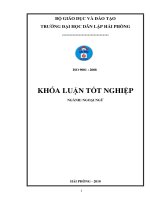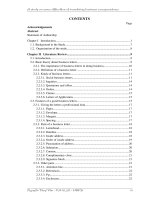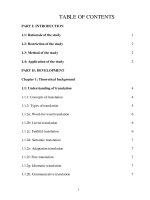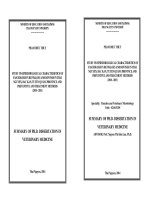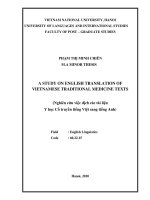A study on profile characteristics of rural women having children between the age group of 6 month to 24 month
Bạn đang xem bản rút gọn của tài liệu. Xem và tải ngay bản đầy đủ của tài liệu tại đây (186.08 KB, 6 trang )
Int.J.Curr.Microbiol.App.Sci (2020) 9(7): 3649-3654
International Journal of Current Microbiology and Applied Sciences
ISSN: 2319-7706 Volume 9 Number 7 (2020)
Journal homepage:
Original Research Article
/>
A Study on Profile Characteristics of Rural Women Having Children
between the Age Group of 6 Month to 24 Month
Lopamudra Mohapatra1*, R. Neela Rani1, R. Geetha Reddy1 and T. Kamalaja2
1
Department of Extension Education and Communication Management, Hyderabad,
Professor Jayashankar Telangana State Agricultural University, Telangana, India
2
Department of Food and Nutrition, Hyderabad, Professor Jayashankar Telangana State
Agricultural University, Telangana, India
*Corresponding author
ABSTRACT
Keywords
Empowerment,
Food security,
Malnutrition, Mass
media, Extension
contact
Article Info
Accepted:
22 June 2020
Available Online:
10 July 2020
The present study was undertaken to study the profile characteristics of
rural women having children between 6 month and 24 months of age. A
total sample of 120 rural mothers was selected through purposive random
sampling method. Ex- post facto research design was used for the study.
The study was conducted by using a structured interview schedule. The
data was analysed using frequency and percentage. In the study the result
revealed that majority of the respondents were belonged to the age of < 25
year (60%), were illiterate (25.84%), had agriculture (36.67%) as
occupation, nuclear family (67.50%), medium income (50.83%), small land
holding (50%) ,1 to 2 children (79.16%) , low mass media exposure
(74.17%) and low extension contact (90.83%).
Introduction
Rural women are active agents of economic
and social change in many ways and to
various degrees, whereas they have
constrained in their roles as farmers,
producers,
investors,
caregivers
and
consumers. They play crucial roles ensuring
food and nutrition security, eradicating rural
poverty and improving the well-being of their
families. Still the women continue to face
serious challenges as a result of gender-based
stereotypes and discrimination that deny them
equitable access to opportunities, resources,
assets and services. It was seen that mothers
empowerment have a positive impact on the
nutritional status of their child. In the context
of child health outcomes, given that women
are typically the primary caretakers of
children, redirecting of decision-making roles
in favour of women has the potential to
improve child health outcomes. Although
3649
Int.J.Curr.Microbiol.App.Sci (2020) 9(7): 3649-3654
there has been a decline in the rates of
moderately underweight and stunted children,
India continues to have one of the worst
levels of low birth weight and underweight
children when compared to other nations. The
indicators of women’s empowerment, such as
the education of the mother and employment
status had a negative relationship with child
malnutrition Shafiq (2019).
of child. Hence majority of the respondents
were from less than 25 years.
Education
The profile characteristic of women plays a
major to increase the knowledge and
empower them in all the aspects. By taking
the above points from the situation the study
was conducted to find out the profile
characteristic of rural women.
From table 1 it could be depicted that most of
the respondents (25.84%) were illiterate
followed by high school education (23.33%),
primary school (20.84%), college education
(18.66%) and middle school education
(13.33%). Education is one of the asset which
will create awareness about good nutrition
and health among rural women. But from the
study it could be found out that about half of
the respondents are illiterates and had
education up to primary school.
Materials and Methods
Occupation
In the present study Ex-post facto research
design was followed. Medak district was
selected. From the selected district, randomly
4 mandals were selected and total of 8
villages were selected randomly. From each
village 15 respondents were selected
purposively those who were having child
between the age of 6 month to 24 month.
Thus a total of 120 samples were selected for
the present study. An interview schedule was
used by doing suitable modifications. The
data was organized, tabulated and classified
using
qualitative
and
quantitative
classification and subjected to statistical tests.
The statistical tools were Frequency and
percentage.
From table 1 it could be found out that
majority of the respondents (36.67%) had
agriculture as their occupation followed by
housewife (33.33%), labour (20.83%), small
business (07.50%) and government job
(01.67%). Most of the respondents occupation
were agriculture due to the reason that as
most of the respondents were illiterates so
they were working in their own land. Also as
the respondents were mothers of 6-24 months
of child so they are staying at home as
housewife.
Results and Discussion
Age
From table no. 1 it could be concluded that
majority of the respondents (60%) were
belonged to the age group of less than 25
years followed by 25 to 35 years (30.83 %)
and more than 35 years (09.17%). The reason
might be that majority of the respondents got
married early which leads to early conception
Income of family
From table 1 it could be revealed that
majority of the respondents (50.83%)
belonged to the middle income group
followed by low income (47.50%) and high
income (1.67%). The main reason might be as
most of the respondent occupation was
agriculture and housewife.
Family type
From table 1 it could be found out that
majority of the respondents (67.50%) were
belonged to the nuclear family followed by
3650
Int.J.Curr.Microbiol.App.Sci (2020) 9(7): 3649-3654
joint family (30.00%) and extended family
(02.50%). This may be due to the joint family
tradition of the system changed from
extended to nuclear families because of the
modern economic & social development in
society.
Land holding
From table 1 it could be depicted that
majority of the respondents (50%) were
belonged to the category of small land
holding followed by marginal land holding
(28.34%), semi- medium land holding
(13.33%) and medium land holding (08.33%).
Number of children
From table no. 1 it could be concluded that
majority of the respondents (79.16%) had 1 to
2 children followed by 3 to 4 children
(20.84%). The reason might be increased
awareness by different national and
international programmes for controlling the
population growth.
Age of the child
From table 2 it could be depicted that
majority of the respondents (54.17%) had
child between the age group of 12 to 24
month followed by 6 to 8 months (25%) and 9
to 11 months (20.83%). Majority of the
children were coming in between 12 to 24
months because of the time taken in this
category was 12 month were as the other two
age category had only two months of time.
Gender of the child
From table 2 it could be stated that majority
(59.17%) of the respondents had male child
followed by female child (41.83%). The
reason might be low sex ratio in India i.e.,
943 females per 1000 male (Census 2011).
Birth order of the child
From table 2 it could be concluded that
among the respondents, majority (50%) of
them had first child followed by second child
(35%) and third child (15%). A number of
researcher show a great influence of birth
order contributes child’s behaviour, career
choice, intelligence of child to certain degree
but the child born in order of first, second, last
or any other doesn’t have great importance
Gupta (2019).
Birth weight of the child
From table 2 it could be found out that
majority (55%) of the child’s birth weight
were between the category of 2600 – 3000 g
followed by more than 3000g (31.67%) and
2100 -2500g (13.33%). From the study we got
that majority of the children were having
normal birth weight.
Type of delivery
From table 3 it could be found out that
majority (59.17%) of the respondents had
given birth through normal delivery followed
by caesarean delivery (40.83%). Though
caesarean delivery rate is increasing in India
from 7.1 NFHS-2 to 10.2 in NFHS-3 but still
majority of the respondents in rural preferred
normal delivery due to fear of caesarean
delivery.
Mass Media Exposure
From table 3 it could be found out that
majority (90.83%) of the respondents had low
mass media exposure followed by medium
(21.66%) and high (04.17%) mass media
exposure. As most of time respondents were
engaged into agriculture and household work
which they were hindering them to get
exposed into mass media. The another reason
might be the illiteracy and low income level
among the respondents.
3651
Int.J.Curr.Microbiol.App.Sci (2020) 9(7): 3649-3654
Table.1 Distribution of rural women according to their profile characters
S. No.
Category
1.
Frequency
n= 120
Percentage
(%)
72
37
11
60.00
30.83
09.17
31
25
16
28
20
25.84
20.84
13.33
23.33
18.66
Age
a)
b)
c)
< 25
25-35
> 35
2.
Education
a)
b)
c)
d)
e)
Illiterate
Primary School
Middle School
High School
College education
3.
Occupation
a)
b)
c)
d)
e)
4.
a)
b)
c)
5.
a)
b)
c)
6.
a)
b)
c)
d)
e)
7.
a)
b)
c)
Agriculture
Labour
Small business
Government job
Housewife
44
25
9
2
40
Income of Family (Annual in Rupees)
Low income (Below 60,000)
57
Medium income (60,000-1,20,000)
61
High income (above 1,20,000)
02
Family Type
Nuclear Family
81
Joint Family
36
Extended family
03
Land Holding
Marginal holding
34
Small holding
60
Semi- medium holding
16
Medium holding
10
Large holding
0
Number of children
1-2
95
3-4
25
Above 4
0
3652
36.67
20.83
07.50
01.67
33.33
47.50
50.83
01.67
67.50
30.00
02.50
28.34
50.00
13.33
08.33
00.00
79.16
20.84
00.00
Int.J.Curr.Microbiol.App.Sci (2020) 9(7): 3649-3654
Table.2 Distribution of rural women according to the General information about their child
n= 120
S. No.
Category
Frequency
Percentage (%)
1.
Age of the Child
6-8 Month
30
25.00
a.
9-11
Month
25
20.83
b.
12-24 Month
65
54.17
c.
2.
Gender of the child
Male
71
59.17
a.
Female
49
40.83
b.
3.
Birth order of the child
First child
60
50.00
a.
Second child
42
35.00
b.
Third child
18
15.00
c.
Fourth child
0
0.00
d.
More
than
Four
0
0.00
e.
4.
Birth Weight of the child
≤ 2000 g
00
00
a.
2100 - 2500 g
16
13.33
b.
2600 – 3000 g
66
55.00
c.
> 3000 g
38
31.67
d.
5. Type of Delivery
Normal delivery
71
59.17
a.
Caesarean delivery
49
40.83
b.
Table.3 Distribution of rural women according to the Mass Media Exposure
n=120
S.No.
a.
b.
c.
Mass Media Exposure
Low
Medium
High
Frequency
89
26
05
Percentage (%)
74.17
21.66
4.17
Table.4 Distribution of rural women according to the Extension Contact
n= 120
S.No.
a.
b.
c.
Extension Contact
Low (8-18)
Medium (19-29)
High (30-40)
Frequency
109
11
00
Extension contact
From table 3 it could be found out that
majority of the respondents (90.83%) had low
extension contact followed by medium
Percentage (%)
90.83
09.17
00
(21.66%) and high (04.17%) extension
contact. The reason for these results of low
extension contact may be due to illiteracy,
shyness, ignorance which inhibits them to get
into contact with extension personnel. It was
3653
Int.J.Curr.Microbiol.App.Sci (2020) 9(7): 3649-3654
also observed that respondents had good
contacts with Anganwadi workers when
compared to other extension personnel. The
findings were similar with the findings of
Deepika (2019).
References
Bidwe, A.R. 2018. Study on Infant and
Young
child
feeding
practices,
formulation of weaning foods and their
popularization. PhD. Thesis. Vasantrao
Naik Marathwada Krishi Vidyapeeth,
Parbhani, India.
Deepika, K.S. 2019. Effect of child
discrimination on the education of girl
child in rural and tribal areas of
Telangana
state.
M.Sc.
Thesis.
Professor Jayashankar Telangana State
Agricultural University, Hyderabad,
India.
Gupta, V. 2019. A study on complementary
feeding practices prevalent in rural
areas of Faizabad District. Ph.D Thesis.
Sam Higginbottom University of
Agriculture, Technology and Sciences,
Allahabad (Prayagraj), India.
Islam, M and Mustaquim, MD. 2014. Socio
economic status of rural population an
income level analysis. Asian academic
research Journal of multidisciplinary. 1
(24): 98-106.
Manjunatha, B.R and Gangadhar, M.R. 2018.
Socio-Economic
Status
of
the
Bettakuruba Tribal Women: a Case
Study from the Chamarajanagara
District, Karnataka. Antrocom Journal
of Anthropology. 14 (1): 129-137.
Shafiq, A., Hussain, A., Asif, M., Hwang, J.,
Jameel, A. and Kanwel, S. The Effect of
“Women’s Empowerment” on child
Nutritional
Status
in
Pakistan.
International Journal of Environmental
Research and Public Health.
How to cite this article:
Lopamudra Mohapatra, R. Neela Rani, R. Geetha Reddy and Kamalaja, T. 2020. A Study on
Profile Characteristics of Rural Women Having Children between the Age Group of 6 Month
to 24 Month. Int.J.Curr.Microbiol.App.Sci. 9(07): 3649-3654.
doi: />
3654



